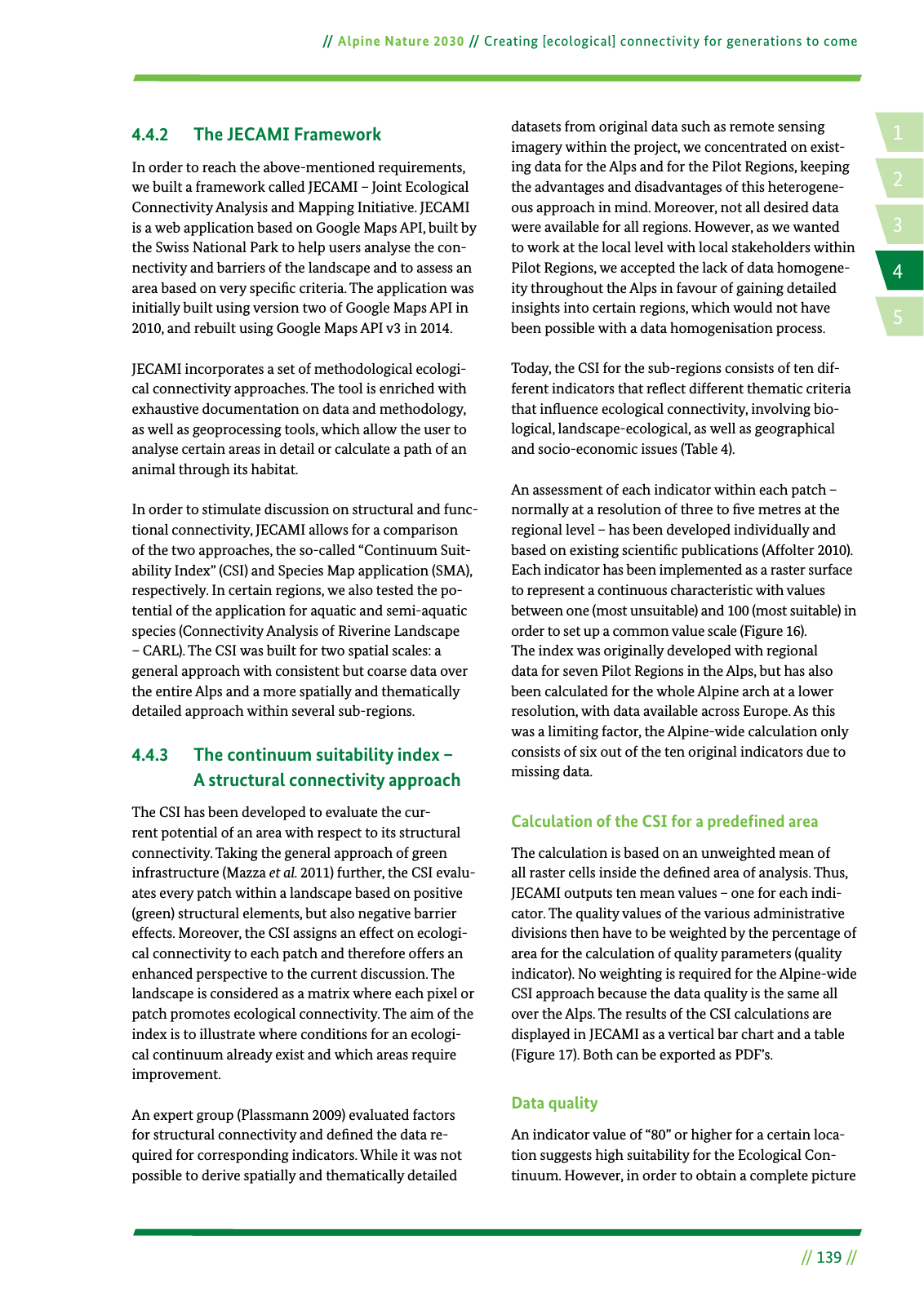14 2 5 3 Alpine Nature 2030 Creating ecological connectivity for generations to come 139 4 4 2 The JECAMI Framework In order to reach the above mentioned requirements we built a framework called JECAMI Joint Ecological Connectivity Analysis and Mapping Initiative JECAMI is a web application based on Google Maps API built by the Swiss National Park to help users analyse the con nectivity and barriers of the landscape and to assess an area based on very speci c criteria The application was initially built using version two of Google Maps API in 2010 and rebuilt using Google Maps API v3 in 2014 JECAMI incorporates a set of methodological ecologi cal connectivity approaches The tool is enriched with exhaustive documentation on data and methodology as well as geoprocessing tools which allow the user to analyse certain areas in detail or calculate a path of an animal through its habitat In order to stimulate discussion on structural and func tional connectivity JECAMI allows for a comparison of the two approaches the so called Continuum Suit ability Index CSI and Species Map application SMA respectively In certain regions we also tested the po tential of the application for aquatic and semi aquatic species Connectivity Analysis of Riverine Landscape CARL The CSI was built for two spatial scales a general approach with consistent but coarse data over the entire Alps and a more spatially and thematically detailed approach within several sub regions 4 4 3 The continuum suitability index A structural connectivity approach The CSI has been developed to evaluate the cur rent potential of an area with respect to its structural connectivity Taking the general approach of green infrastructure Mazza et al 2011 further the CSI evalu ates every patch within a landscape based on positive green structural elements but also negative barrier effects Moreover the CSI assigns an effect on ecologi cal connectivity to each patch and therefore offers an enhanced perspective to the current discussion The landscape is considered as a matrix where each pixel or patch promotes ecological connectivity The aim of the index is to illustrate where conditions for an ecologi cal continuum already exist and which areas require improvement An expert group Plassmann 2009 evaluated factors for structural connectivity and de ned the data re quired for corresponding indicators While it was not possible to derive spatially and thematically detailed datasets from original data such as remote sensing imagery within the project we concentrated on exist ing data for the Alps and for the Pilot Regions keeping the advantages and disadvantages of this heterogene ous approach in mind Moreover not all desired data were available for all regions However as we wanted to work at the local level with local stakeholders within Pilot Regions we accepted the lack of data homogene ity throughout the Alps in favour of gaining detailed insights into certain regions which would not have been possible with a data homogenisation process Today the CSI for the sub regions consists of ten dif ferent indicators that re ect different thematic criteria that in uence ecological connectivity involving bio logical landscape ecological as well as geographical and socio economic issues Table 4 An assessment of each indicator within each patch normally at a resolution of three to ve metres at the regional level has been developed individually and based on existing scienti c publications Affolter 2010 Each indicator has been implemented as a raster surface to represent a continuous characteristic with values between one most unsuitable and 100 most suitable in order to set up a common value scale Figure 16 The index was originally developed with regional data for seven Pilot Regions in the Alps but has also been calculated for the whole Alpine arch at a lower resolution with data available across Europe As this was a limiting factor the Alpine wide calculation only consists of six out of the ten original indicators due to missing data Calculation of the CSI for a predeªned area The calculation is based on an unweighted mean of all raster cells inside the de ned area of analysis Thus JECAMI outputs ten mean values one for each indi cator The quality values of the various administrative divisions then have to be weighted by the percentage of area for the calculation of quality parameters quality indicator No weighting is required for the Alpine wide CSI approach because the data quality is the same all over the Alps The results of the CSI calculations are displayed in JECAMI as a vertical bar chart and a table Figure 17 Both can be exported as PDF s Data quality An indicator value of 80 or higher for a certain loca tion suggests high suitability for the Ecological Con tinuum However in order to obtain a complete picture

Hinweis: Dies ist eine maschinenlesbare No-Flash Ansicht.
Klicken Sie hier um zur Online-Version zu gelangen.
Klicken Sie hier um zur Online-Version zu gelangen.